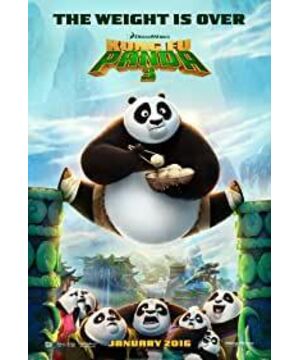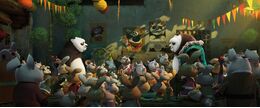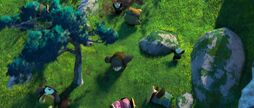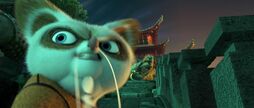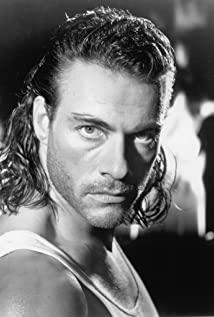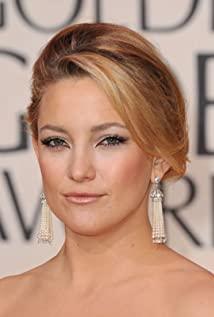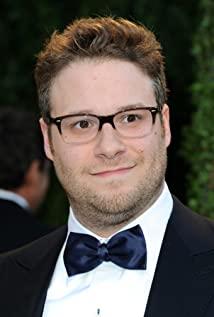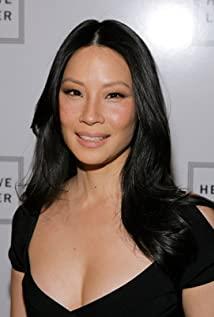Recommended or not: Recommend
a little spoiler but it doesn't affect the viewing (because there is nothing to spoil)
I love "Kung Fu Panda" very much, especially the first one in 2008, because it was the first time I saw a foreign country People use Chinese elements in such a masterful way, and in addition to admiration, they also feel that they are slapped in the face: those things of the ancestors were all used by others to make money - and here they are willing to pay their own money.
In the blink of an eye, "Kung Fu Panda" has also been made into a series, and it is very likely that the filming will continue, which is really gratifying.
Therefore, when evaluating this "Kung Fu Panda 3", in addition to considering it as an independent work, it should also be regarded as a part of the series. Its true value can only be seen by comparing it to its predecessors and discussing its place in the series.
First of all, the production of "Kung Fu Panda 3" - DreamWorks' dream-making technology is absolutely first-class, and it has become more sophisticated over the years, so the production effect of the third film is naturally better than the first and second. This is mainly manifested in two aspects. One is the fineness of the picture, such as the newly unveiled Panda Village:
crew also specially shot Mount Qingcheng in Sichuan for this purpose.
The second one is less well-known, that is, the Chinese style artistic conception created by comprehensive viewing and listening. As mentioned before, the main creator has a good grasp of Chinese elements. For example, the first part starts with a freehand two-dimensional screen, which is quite martial arts style: a master wearing a hat, walking alone, hunting with flags and flags, and melodious flute; Although he is alone, he is majestic and has a head start:
The opening of the second part is also a two-dimensional paper-cut picture, with string music, which is very suitable for telling legends:
Some of the third part are used to contrast Emotional soft scenes, such as the setting sun reflecting the snow, the main creator is really useless:
This scene is used to highlight the affection between father and son.
This scene is used to highlight the changes in Po's mentality.
It can be seen from these pictures that the entire series, including the third part, is handy in using Chinese elements of painting, sound and even the overall artistic conception. In particular, although the entire series is produced in 3D by computer, and visually presented in 3D, in fact, the screen often switches between two-dimensional and three-dimensional, and there is no sense of disobedience.
Next, let's talk about what's inside under production. Here is where I am a little disappointed.
In fact, there is not much to say about the plot. After all, this is a "standard" family-friendly movie - all the foreshadowing, development, turning points and climaxes are as expected in textbooks, and it can only be said that it is shot in many Hollywood works. It is not successful (it is still a lot stronger than domestic animation).
The way the theme is expressed in the plot and the theme itself are also very superficial (even a bit rough): a threat has appeared in the martial arts (Dalong, Shen Wangye, Tiansha), and Bao must learn a new skill (Dragon Scroll, Heart Like Still Water) , Qigong), after all kinds of ups and downs and mutual help, he found that the secret of learning martial arts is actually outside of martial arts (be yourself, face the past, help relatives and friends); mapped to reality, the secret of success is also outside of success.
The martial arts part has deteriorated considerably in my opinion. An important innovation of the "Kung Fu Panda" series is "returning to the basics" - the essence of Chinese pictographic boxing learned from animals is put back into animals. The animal image will strengthen the styles of various martial arts, so it is very visible. Take a look at the showdown between the Tough Tiger and Linghe in the first part:
In reality, Linghe represents many styles of Hequan, and their characteristics are similar to those of Taijiquan. The plot of Linghe shooting down arrows with soft feathers fits this feature very well. In the battle between the troll tiger and the linghe, the troll tiger fully demonstrated the characteristics of the tiger fist, which is ferocious, fierce, and short-handed, while the linghe is generous and flexible.
The other characters also have moves that fit their own characteristics - except that their kicks are too much like Bruce Lee.
In the second part, there are still many classic fighting scenes that match the character's martial arts style and personal characteristics. For example, in the scene of subduing the wolf soldier at the beginning, the brave style of the tiger is still obvious:
A Baoze Like Jackie Chan, he always wins by playing tricks:
And this scene also adds a blind rabbit playing the pipa, which is exactly the same as the blind artist playing the piano in the classic idea showdown between Jet Li and Donnie Yen in "Heroes". It is very cleverly used.
When it came to the third part, I instantly felt that there were less fights that boosted adrenaline. The only thing that felt good was the scene where the six people fought against the Jade Zombies at the beginning, and it was perfect to arrange the porcupine as the archer. There is nothing left, probably because all the martial arts masters were taken over by Tiansha from the beginning. In the end, the duel between Abao and Tiansha in the underworld - the creators may want to show a higher-level martial arts duel in their minds, so it's a bit fancy. This scene may seem to foreigners to be more pretentious, but to Chinese people... In short, I still prefer real martial arts.
The villain this time can be said to be the strongest in history-because they are not mortals, and the big dragon, Lord Shen, must stand aside. But being strong and strong seems to be not very grounded - that is to say, apart from being strong, there is no other characteristic of it. The villains of the first two films are also very strong, and other characteristics are very obvious.
The big dragon in the first part is wild - he is the most like animal of all the animals in the whole film. His desperate pursuit of martial arts is terrifying.
He forbears until he is free. He can't see the reaction when his tail is stepped on, giving a gloomy and terrifying feeling, which is in stark contrast to the stupid rhino army officer:
When unlocking the lock with feathers, he showed great skill:
After that, he punched all the way out of the cell , really let people know what is the bestiality:
is such a character with both wisdom and courage, and at the same time crazy.
What about Lord Shen in the second part? is sinister. Even the voice is feminine. He is dubbed by the perverted professional Gary Oldman, just look at the "This Killer Is Not Too Cold" he played.
Shen Wangye's first appearance was just a vague shadow, uttering wild words: "China will be mine."
After that, he showed gorgeous martial arts, ropes, feathers, and hidden weapons, which made people dizzy:
This villain is skilled, wicked, and likes to pretend, not to mention that he is also an inventor, and he invented the artillery that can destroy martial arts - a completely different type from Dalong. Impressive villain.
What about the third fiend? What's impressive about him? He's too god-like to have any other "human" qualities.
Finally, although "Kung Fu Panda" shows Hollywood's understanding of Chinese culture, there are still some places where they feel inconsistent because they don't understand China.
For example, in the second part, A Bao used martial arts to destroy the artillery. Anyone familiar with Chinese history knows that the fact is exactly the opposite: the strong boat and the artillery not only destroyed the martial arts, but also blew the Chinese social system to smithereens. So, the artillery was destroyed by "the heart is like still water", which really surprised me. It would be better to put the appearance of firearms in the next few parts, and use firearms to explore the ultimate meaning of martial arts existence and sublimate the theme of the entire series, rather than making soy sauce in a certain part.
In the third part, A Bao mastered qigong by relying on the "love" of relatives and friends, which also made me a little embarrassed. These are all the results of the main creator who inserted these Chinese elements into the film as concepts, but only "hyped up" them without further research. In fact, compared to the far-reaching influence of Chinese culture in production, the influence of Chinese culture in creation is very superficial, or it is actually the American thing in its bones.
Of course, as a cartoon, it may not be necessary to study so much, and there is no need to ask foreigners to understand Chinese culture so much, just enjoy watching it. In terms of happiness, the third part is as good as the previous one. Especially in the battle deployment in Panda Village, people laughed.
As a single product, "Kung Fu Panda 3" is qualified. So why say I'm a little disappointed? Because although the plot and theme of the third part are not successful, it does not surpass the previous one. That in itself is a pity. What's more, in the third volume, the master also taught Bao: "If you don't do things that surpass yourself, you will never progress."
Isn't this ironic?
Therefore, I hope that "Kung Fu Panda" can continue to be filmed, and I hope to see Po's continuous improvement.
This article was first published on Observer.com, column: Sweet
Potato Children who like this article can pay attention to my public account: film filter.
View more about Kung Fu Panda 3 reviews


